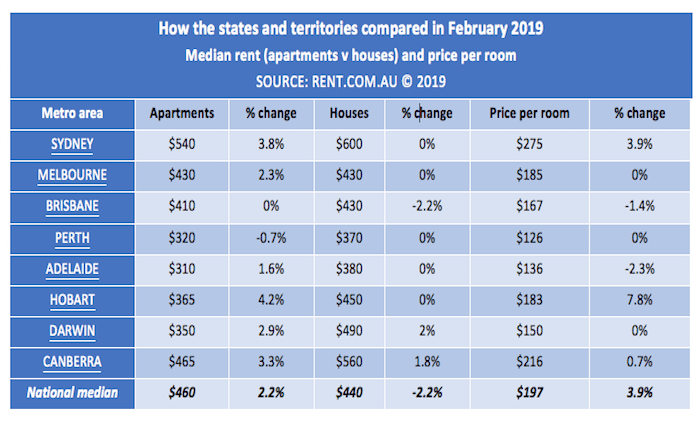Rents continue to rise despite fall in property prices
Property prices have fallen in most major centres, but there seems to be little relief in sight for struggling tenants as rents continue to increase, according to new data.
Analysis by rent.com.au shows rents in February increased in all capital cities except Brisbane and Perth, but experts say that may change soon.
The increase follows a trend of growing rental prices within the past 12 months as the nation grappled with a lack of affordable housing.
In 2018, house prices dropped by an average of 4.8% across the nation, prompting Deutsche Bank to identify a potential Australian housing crash as one of the top 30 risks to the global economy.
While the current rise in rents seems out of step with the downward trend in house prices, experts say it is to be expected.

Source: Rent.com.au
Static incomes, rising interest rates for existing borrowers and population growth are offsetting lower renting costs across cities.
“Rents and house prices can move in different directions at the same time,” University of New South Wales City Futures research fellow Chris Martin said.
“This is because house prices have a speculative component that rents do not have. Rents more directly reflect demand for, and supply of, housing as housing. By contrast, house prices also reflect a degree of speculation – that is, housing as an asset, that someone else might pay more for later.”
For the past decade, housing prices across the major capitals have risen well above the trend in rents due to low interest rates and “rampant speculation” from investors keen to capitalise on the skyrocketing prices.
Now, would-be buyers have lost confidence and are pulling out of the market, resulting in the price drop.
“This also means that construction commencements have also contracted, as developers are less confident about finding buyers. If this persists, this may result in supply pressures on rents,” Martin said.
Greg Bader, the CEO of rent.com.au, says the recent increase has also been influenced by an influx of demand in the market, as students seek suitable accommodation.
“In isolation, falling house prices don’t tend to impact rents directly. However, a market downturn can lead to an oversupply of properties, which does then flow through to an eventual drop in rental prices,” Bader said.
“But this can be a slow burn.”
While the February market snapshot shows a small lift in rental prices across the peak season, Bader stresses that renters are “yet to see the impact of a housing downturn”.
There are more than 2.1 million Australians living in rental properties, with the 2016 census showing that the nation’s cohort of renters is on the rise with almost as many Australians renting, as those that own their houses.
In November, the latest Rental Affordability Index – an indicator of rental affordability relative to household incomes – found that “renters currently spend an average of 20% of their income on housing costs, while owners with a mortgage pay 16%”.
Bader said that potential renters looking for the downturn to influence cheaper rents will have to wait a while.
“With the number of properties available increasing in many areas, it’s likely that the market will see some softening as demand teeters off – most likely in areas where there’s some oversupply [apartments] and in outer suburbs where there’s more choice,” he said.
The best thing that renters can do in the meantime is to narrow down locations, research lifestyle options and be prepared to compromise, he said.
“Don’t be afraid to look at neighbouring suburbs which can offer just as many lifestyle options but can come at a significant discount and save you money,” Bader said.
“Be flexible. You may need to compromise on some things, but go in with an idea of what’s most important to you, e.g. a good kitchen over parking space.”
